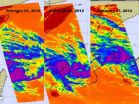(Press-News.org) Athens, Ga. – Heat-related deaths among football players across the country tripled to nearly three per year between 1994 and 2009 after averaging about one per year the previous 15 years, according to an analysis of weather conditions and high school and college sports data conducted by University of Georgia researchers.
The scientists built a detailed database that included the temperature, humidity and time of day, as well as the height, weight and position for 58 football players who died during practice sessions from overheating, or hyperthermia. The study, published recently in the International Journal of Biometeorology, found that for the eastern U.S., where most deaths occurred, morning heat index values were consistently higher in the latter half of the 30-year study period. Overall, Georgia led the nation in deaths with six fatalities.
"In general, on days the deaths occurred, the temperature was hotter and the air more humid than normal local conditions," said climatologist Andrew Grundstein, senior author of the study and associate professor of geography in the UGA Franklin College of Arts and Sciences.
More than half of the players fell ill on days when practice ended before noon. The majority of the deaths occurred in August, when most high school and college football coaches ramp up preseason training. The American College of Sports Medicine provides guidelines for the intensity of all sports practices based on a measurement called the wet bulb globe temperature, or WBGT.
The WBGT reading is calculated using the familiar dry bulb thermometer usually found in homes, a wet bulb thermometer wrapped in damp cotton and, finally, a dry bulb thermometer encased in a black globe or globe thermometer. Each instrument provides, respectively, a measure of the air temperature, the ability of evaporation to cool the player, and the amount of solar radiation absorbed by a surface or, in this case, the player's exposed skin.
The National Weather Service provides a measurement called the heat index that attempts to convey true ambient temperature. The weakness of that measurement, Grundstein explained, is that it does not account for sun exposure or a person's involvement in athletic activity.
Neither method of measuring temperature accounts for the protective pads and helmets football players wear during practice.
"We all want a single magic number to indicate the heat threshold," Grundstein said. "But so many factors contribute to heat stress that it's impossible to draw the line at a single temperature."
Grundstein cautioned against assigning complete blame for the deaths on warmer temperatures and increasing humidity. He found that football players have also grown larger since 1980. Linemen, who tend to have a higher body mass index than other players, seem especially susceptible to hyperthermia. In Grundstein's sample, 86 percent of those who died were linemen. The increase in deaths also could be explained by an overall increase in weight and BMI in the past 15 years.
Even though specialized tools such as the wet bulb global thermometer are available, not all football coaches decide to use them. In addition to knowing the true temperature outdoors, another approach to avoiding heat illnesses is to make sure players are slowly introduced to an intense workout regime after a summer probably spent inside air-conditioned environments. It is also important to have trained staff watching for signs of heat illness and to have an emergency management plan in place, he said.
Grundstein is currently working with Mike Ferrara, professor of kinesiology in the UGA College of Education, to study heat-related injuries in Georgia high school football players. Deaths from hyperthermia, Grundstein said, are highly avoidable.
###Co-authors, all from UGA, include associate professor of geography John Knox and graduate students Craig Ramseyer, Fang Zhao, Jordan L. Pesses, Pete Akers, Aneela Qureshi, Laura Becker and Myron Petro.
Deaths triple among football players, morning temperatures thought to play a role
2012-02-29
ELSE PRESS RELEASES FROM THIS DATE:
Story on human genetic origins is one of EurekAlert!’s most-visited releases in 2011
2012-02-29
A striking discovery in the study of human genetics was the focus of the most-visited press release posted on EurekAlert! in 2011. Researchers found that part of the non-African human X chromosome came from Neanderthals, confirming that they interbred with early human populations.
Breakthroughs in mathematics, physics, chemistry, and medicine, along with discoveries in zoology, psychology, and astrobiology, were also featured in the 10 releases most often viewed by EurekAlert! readers in 2011.
Website statistics collected over the course of the year identified the year's ...
Holiday Inn Express & Suites Newberry SC Hotel Offers Special Rates to the Irish Fling Celebration
2012-02-29
The Holiday Inn Express & Suites Newberry SC Hotel offers special rates to guests attending the Irish Fling Celebration. The annual Newberry Irish Fling will take place on Friday, March 16, 2012 in downtown Newberry. It will celebrate St. Patrick's Day and includes live entertainment and festivities at various locations in Newberry. Performing live at the Newberry Opera House, headline entertainment will be Martha Reeves and the Vandellas. Show time is 8:00 PM and tickets can be purchased at the Newberry Opera House Box Office.
"The Newberry Irish Fling is ...
Rocket launches from Poker Flat Research Range
2012-02-29
Fairbanks, Alaska -- On Saturday, Feb. 18 at 8:41 p.m. Alaska time, scientists launched a NASA sounding rocket from Poker Flat Research Range into a brilliant aurora display. The rocket mission, designed to gather information on space weather conditions that affect satellite communications, was a success.
"It was a terrific aurora, the rocket worked great, the instruments worked great and the supporting radar (at Poker Flat) worked wonderfully," said Steve Powell of Cornell University, the principal investigator for the launch. "We achieved all of our objectives. We're ...
Ultra-fast outflows help monster black holes shape their galaxies
2012-02-29
A curious correlation between the mass of a galaxy's central black hole and the velocity of stars in a vast, roughly spherical structure known as its bulge has puzzled astronomers for years. An international team led by Francesco Tombesi at NASA's Goddard Space Flight Center in Greenbelt, Md., now has identified a new type of black-hole-driven outflow that appears to be both powerful enough and common enough to explain this link.
Most big galaxies contain a central black hole weighing millions of times the sun's mass, but galaxies hosting more massive black holes also ...
Research sheds light on how immune system's 'first responders' target infection
2012-02-29
University of Texas Medical Branch at Galveston researchers have discovered previously unsuspected aspects of the guidance system used by the body's first line of defense against infection.
The new work focuses on the regulation of immune response by two forms of the signaling molecule IL-8, as well as IL-8's interaction with cell-surface molecules called glycosaminoglycans (or GAGs for short).
Infected or injured tissues release IL-8 to attract bacteria- and virus-killing white blood cells known as neutrophils, a process known as "recruitment." As IL-8 proteins disperse ...
Upper class more likely to be scofflaws
2012-02-29
The upper class has a higher propensity for unethical behavior, being more likely to believe – as did Gordon Gekko in the movie "Wall Street" – that "greed is good," according to a new study from the University of California, Berkeley.
"The increased unethical tendencies of upper-class individuals are driven, in part, by their more favorable attitudes toward greed," said Paul Piff, a doctoral student in psychology at UC Berkeley and lead author of the paper published today (Monday, Feb. 27) in the journal Proceedings of the National Academy of Sciences.
Piff's study ...
3 days of NASA infrared images show System 92S tropically developing
2012-02-29
NASA satellites have been watching the low pressure area called System 92S for days, and infrared imagery from NASA's Aqua satellite showed cloud temperatures were cooling, indicating the storm was getting more organized after it moved over northern Madagascar. Now it may be headed for landfall in Mozambique.
The Atmospheric Infrared Sounder (AIRS) instrument on NASA's Aqua satellite captured infrared imagery on developing System 92S as it moved from the Southern Indian Ocean, west across northern Madagascar and into the Mozambique Channel. On February 25 at 0941 UTC, ...
Hays Reports Tunnel Vision Trapping Workers and Hindering Growth
2012-02-29
The Hays Career Outlook Survey has revealed that workers are being trapped in career silos because they don't believe they can cross sector or industry boundaries, according to new data from the Hays Career Outlook Survey. The survey also highlights that employers in both sectors are often unable to recognise the transferable skills that might help them to identify potential candidates who are capable of supporting their growth plans.
The survey reveals the vast majority of employers believe that previous experience in the same sector is important. Whilst only just ...
Salty soil can suck water out of atmosphere: Could it happen on Mars?
2012-02-29
CORVALLIS, Ore. – The frigid McMurdo Dry Valleys in Antarctica are a cold, polar desert, yet the sandy soils there are frequently dotted with moist patches in the spring despite a lack of snowmelt and no possibility of rain.
A new study, led by an Oregon State University geologist, has found that that the salty soils in the region actually suck moisture out of the atmosphere, raising the possibility that such a process could take place on Mars or on other planets.
The study, which was supported by the National Science Foundation, has been published online this week ...
Modified bone drug kills malaria parasite in mice
2012-02-29
CHAMPAIGN, Ill. — A chemically altered osteoporosis drug may be useful in fighting malaria, researchers report in a new study. Unlike similar compounds tested against other parasitic protozoa, the drug readily crosses into the red blood cells of malaria-infected mice and kills the malaria parasite. The drug works at very low concentrations with no observed toxicity to the mouse.
The study appears in the Proceedings of the National Academy of Sciences.
The researchers found the drug by screening a library of about 1,000 compounds used in previous efforts to target an ...



